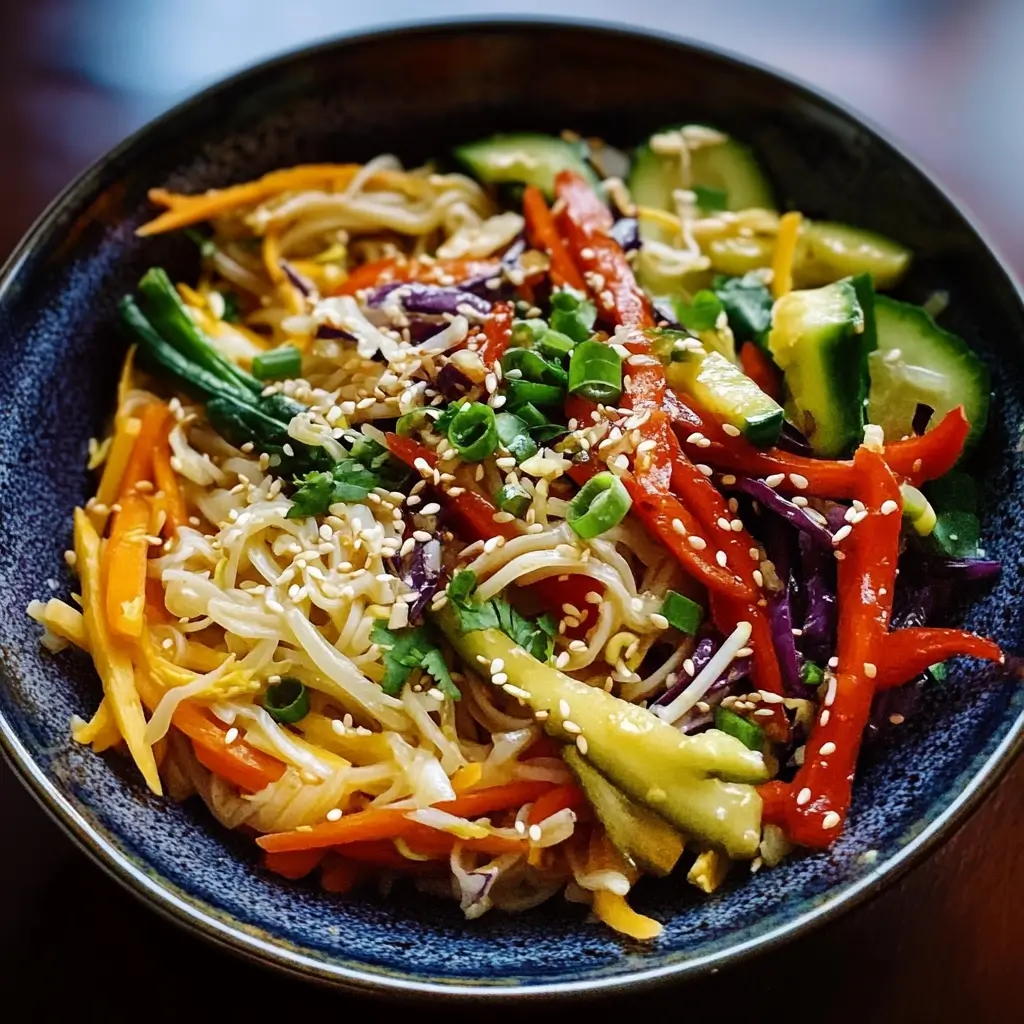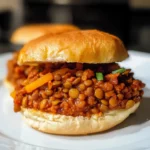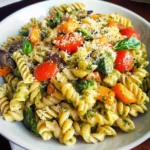This Rice Noodle Veggie Bowl has become an absolute staple in our household, a vibrant explosion of fresh flavors and textures that somehow manages to be both incredibly satisfying and refreshingly light. I first threw it together on a busy weeknight, looking for something quick, healthy, and appealing to everyone, including my sometimes-picky eaters. To my delight, it was an instant hit! The kids loved slurping the soft rice noodles and picking out their favorite crunchy vegetables, while my partner and I appreciated the sophisticated yet simple dressing that ties everything together. It’s the kind of meal that leaves you feeling energized and good about what you’ve eaten. Its versatility is another huge plus; we switch up the veggies based on what’s in season or what we have in the fridge, and sometimes add grilled chicken or shrimp for an extra protein punch. But honestly, the combination of perfectly cooked rice noodles, a rainbow of crisp vegetables, fragrant herbs, and that zesty, savory dressing is a winner every single time. It’s become our go-to for a quick lunch, a light dinner, or even an impressive dish to serve when friends come over. It’s proof that healthy eating can be incredibly delicious and exciting!
Ingredients
Here’s what you’ll need to create this delightful and refreshing Rice Noodle Veggie Bowl:
- For the Noodle Bowl:
- 8 ounces (about 225g) dried rice vermicelli noodles: These are thin, delicate noodles that cook quickly and absorb flavors beautifully.
- 1 large carrot, peeled and julienned or spiralized: Adds sweetness, crunch, and vibrant orange color.
- 1 medium cucumber, julienned or thinly sliced: Provides a refreshing, cool crunch.
- 1 red bell pepper, thinly sliced: Offers a sweet, crisp texture and a pop of bright red.
- 1 yellow or orange bell pepper, thinly sliced: Adds another layer of sweetness and color diversity.
- 2 cups shredded purple or green cabbage: Gives a satisfying crunch and lovely color contrast.
- 1 cup edamame, shelled (cooked and cooled, if frozen): A great source of plant-based protein and a pleasant chewy texture.
- 4 green onions, thinly sliced (both white and green parts): Lends a mild, fresh onion flavor.
- 1 cup fresh cilantro, roughly chopped: Adds a burst of bright, herbaceous flavor.
- 1/2 cup fresh mint leaves, roughly chopped: Provides a cool, aromatic counterpoint to the other flavors.
- Optional protein: 1 block (14-16 ounces) extra-firm tofu, pressed and cubed/pan-fried, or 1 lb cooked shrimp/chicken: For a heartier, more protein-rich meal.
- Optional toppings: 1/4 cup chopped roasted peanuts or cashews, 2 tablespoons sesame seeds, crispy fried shallots: For added texture, crunch, and nutty flavor.
- For the Zesty Dressing:
- 1/4 cup soy sauce (or tamari for gluten-free): The savory, umami base of the dressing.
- 3 tablespoons rice vinegar: Adds a tangy brightness that cuts through the richness.
- 2 tablespoons fresh lime juice (from about 1 lime): Provides a zesty, citrusy kick.
- 1 tablespoon maple syrup (or honey, if not vegan): Balances the acidity with a touch of sweetness.
- 1 tablespoon sesame oil (toasted): Imparts a deep, nutty, aromatic flavor.
- 1-2 cloves garlic, minced or grated: For a pungent, aromatic kick.
- 1 teaspoon fresh ginger, grated: Adds a warm, zesty spice.
- 1/2 teaspoon sriracha or a pinch of red pepper flakes (optional): For a touch of heat, adjust to your preference.
Instructions
Follow these simple steps to assemble your delicious Rice Noodle Veggie Bowl:
- Cook the Rice Noodles: Bring a pot of water to a boil. Add the dried rice vermicelli noodles and cook according to package directions, usually for about 3-5 minutes, until tender but still slightly firm (al dente). Be careful not to overcook them, as they can become mushy. Immediately drain the noodles in a colander and rinse thoroughly with cold water to stop the cooking process and remove excess starch. This helps prevent them from sticking together. Set aside.
- Prepare the Vegetables and Herbs: While the noodle water is heating or the noodles are cooking, use this time efficiently to prepare all your vegetables and herbs. Wash, peel (if necessary), and chop, julienne, spiralize, or slice the carrot, cucumber, bell peppers, cabbage, and green onions as indicated in the ingredients list. Roughly chop the cilantro and mint. If using edamame, ensure it’s cooked and shelled. The goal is to have everything ready for assembly.
- Prepare the Protein (If Using): If you’re adding tofu, ensure it’s pressed to remove excess water, then cut it into cubes or triangles. You can pan-fry it until golden and slightly crispy, bake it, or air-fry it. Season it lightly with soy sauce or salt and pepper if desired. If using shrimp or chicken, cook it according to your preferred method (grilled, pan-seared, baked) and slice or chop as needed.
- Make the Zesty Dressing: In a small bowl or a jar with a lid, combine all the dressing ingredients: soy sauce (or tamari), rice vinegar, fresh lime juice, maple syrup (or honey), sesame oil, minced garlic, grated ginger, and sriracha or red pepper flakes (if using). Whisk thoroughly until the maple syrup is fully dissolved and all ingredients are well combined. Taste the dressing and adjust seasonings if necessary – you might prefer it a bit sweeter, tangier, or spicier.
- Assemble the Bowls: Divide the cooked and cooled rice noodles among four serving bowls. Artfully arrange the prepared vegetables (carrot, cucumber, bell peppers, cabbage, edamame) and green onions over the noodles in distinct sections for a visually appealing presentation. If using tofu, shrimp, or chicken, add it to the bowls as well.
- Garnish and Serve: Drizzle a generous amount of the zesty dressing over each bowl. Sprinkle with the chopped fresh cilantro and mint. If desired, add your chosen optional toppings like chopped roasted peanuts or cashews, sesame seeds, or crispy fried shallots for extra crunch and flavor. Serve immediately, with extra dressing on the side for those who like it saucier.
Nutrition Facts
- Servings: This recipe makes approximately 4 servings.
- Calories per serving: Approximately 400-450 kcal (without optional protein or nuts, can vary based on exact vegetable quantities and dressing amount).
- Fiber: High in dietary fiber (around 8-10g per serving) primarily from the abundance of fresh vegetables and rice noodles, promoting digestive health and satiety.
- Vitamin C: Rich in Vitamin C (significant portion of daily needs) thanks to the bell peppers, cabbage, and lime juice, supporting immune function and collagen production.
- Protein: A good source of plant-based protein (around 10-12g per serving, higher if tofu or edamame is emphasized, significantly more with added animal protein), essential for muscle maintenance and overall bodily functions.
- Healthy Fats: Contains healthy unsaturated fats (around 10-15g per serving) from sesame oil and optional nuts/seeds, which are important for heart health and nutrient absorption.
- Low Saturated Fat: Relatively low in saturated fat, making it a heart-healthy meal choice, especially when focusing on plant-based components.
Preparation Time
- Total Preparation Time: Approximately 25-35 minutes.
- Chopping and Prepping Vegetables: This is the most time-consuming part, taking about 15-20 minutes, depending on your knife skills and whether you use tools like a mandoline or spiralizer.
- Cooking Noodles: Very quick, usually 3-5 minutes, plus time for water to boil.
- Making Dressing: About 5 minutes.
- Assembling Bowls: About 5 minutes.
This recipe is designed for efficiency, especially if you multitask by prepping veggies while the noodle water boils.
How to Serve
This Rice Noodle Veggie Bowl is wonderfully versatile in its presentation. Here are some ideas:
- Individual Bowls:
- Assemble each bowl as described in the instructions, carefully arranging the noodles, vegetables, protein (if using), and herbs in separate, colorful sections.
- Drizzle generously with dressing just before serving.
- Provide extra dressing, chili garlic sauce, or fresh lime wedges on the side for individual customization.
- Garnish with a final sprinkle of sesame seeds or chopped nuts right before it hits the table.
- Family-Style Platter:
- Arrange a large bed of the cooked rice noodles on a large platter.
- Create distinct piles or rows of each prepared vegetable, herb, and protein (if using) around or on top of the noodles. This creates a stunning, vibrant centerpiece.
- Serve the dressing in a small pitcher or bowl on the side, allowing everyone to build their own bowl and dress it to their liking.
- Place small bowls of toppings (nuts, sesame seeds, crispy shallots) alongside the platter.
- Make-Ahead Lunch Bowls:
- Portion the cooked noodles and vegetables into individual meal prep containers.
- Keep the fresh herbs and dressing in separate small containers or small zip-top bags.
- When ready to eat, add the herbs and dressing, toss, and enjoy. This keeps the veggies crisp and herbs fresh.
- Interactive Noodle Bar:
- For a party or gathering, set up a “noodle bar.”
- Have a large bowl of cooked noodles.
- Arrange all the different chopped vegetables, herbs, proteins, and toppings in separate bowls.
- Offer a couple of dressing variations (e.g., the zesty lime dressing and a creamy peanut sauce).
- Guests can then create their own custom Rice Noodle Veggie Bowls. This is always a fun and engaging way to serve a crowd.
- With a Side:
- While this bowl is a complete meal, you could serve it with a light Asian-inspired soup like miso soup or a simple clear broth.
- Spring rolls or summer rolls would also be a complementary appetizer.
Additional Tips
Enhance your Rice Noodle Veggie Bowl experience with these helpful tips:
- Don’t Overcook the Noodles: Rice vermicelli noodles are delicate. Overcooking them will result in a sticky, clumpy mess. Cook them just until tender (al dente) and immediately rinse with cold water to halt the cooking and wash away excess starch. This is crucial for achieving separate, slurp-worthy strands.
- Taste and Adjust Dressing: The dressing is key! Always taste it before tossing it with your bowl. You might prefer it sweeter (add more maple syrup/honey), tangier (more lime juice or rice vinegar), saltier (a bit more soy sauce), or spicier (extra sriracha). Balance is personal.
- Prep Veggies in Advance (Meal Prep Hero): To save time on busy weeknights, chop your carrots, bell peppers, and cabbage ahead of time. Store them in airtight containers in the fridge for up to 2-3 days. This makes assembly incredibly fast.
- Vary Your Veggies: Feel free to get creative! Substitute or add other vegetables like shredded beets, snow peas, snap peas, thinly sliced radishes, blanched broccoli florets, or spinach. The more color and texture, the better.
- Protein Power-Up: For a more substantial meal, add your favorite protein. Crispy pan-fried tofu, marinated tempeh, grilled chicken breast, sautéed shrimp, or even a fried egg on top work wonderfully.
- Make a Double Batch of Dressing: This dressing is so versatile and delicious, you’ll want to use it on salads, as a marinade, or for other noodle dishes. It keeps well in an airtight container in the refrigerator for up to a week.
- Herb Power: Don’t skimp on the fresh herbs like cilantro and mint. They add an incredible layer of freshness and complexity that elevates the dish. Thai basil is another excellent addition if you can find it.
- Storage for Leftovers: If you anticipate leftovers, store the components separately. Keep the cooked noodles, mixed raw vegetables, herbs, and dressing in different airtight containers in the refrigerator. Assemble and dress just before serving to maintain the best texture and freshness. The dressed noodles can become a bit soft if stored for too long.
FAQ Section
Here are answers to some frequently asked questions about this Rice Noodle Veggie Bowl:
- Q: Can I make this recipe vegan?
A: Absolutely! The base recipe is almost entirely vegan. The only adjustment needed is in the dressing: ensure you use maple syrup instead of honey. If you’re adding a protein, opt for tofu, tempeh, or edamame. - Q: Is this Rice Noodle Veggie Bowl gluten-free?
A: Yes, it can easily be made gluten-free. Rice noodles themselves are naturally gluten-free. The key is to use tamari (which is a gluten-free soy sauce alternative) or a certified gluten-free soy sauce in the dressing. Always double-check labels on any pre-made ingredients. - Q: How long will leftovers last in the fridge?
A: For the best quality, it’s recommended to store the components separately. Cooked noodles, chopped vegetables, and dressing can be stored in airtight containers for 2-3 days. Fresh herbs are best added just before serving. If assembled, the bowl is best eaten within 24 hours as the noodles can absorb the dressing and soften, and veggies may lose some crispness. - Q: Can I use different types of noodles?
A: While rice vermicelli noodles are traditional and work best for their light texture, you could experiment. Soba noodles (buckwheat), udon noodles (thicker wheat), or even spaghetti (if you’re in a pinch, though it changes the dish’s character) could be used. Adjust cooking times accordingly. However, for the authentic light and refreshing feel, rice vermicelli is ideal. - Q: What’s the best way to prepare the tofu for this bowl?
A: Pressing extra-firm tofu for at least 30 minutes (or longer) is crucial to remove excess water, allowing it to crisp up better and absorb flavors. After pressing, cube it and then you can pan-fry it in a little oil until golden and crispy, bake it at 400°F (200°C) for 20-25 minutes, or use an air fryer for an even crispier result. Tossing it with a bit of soy sauce or cornstarch before cooking can enhance texture. - Q: Is this dish kid-friendly?
A: Yes, it generally is! Many kids enjoy noodles. You can serve the components separately (deconstructed) and let them choose which veggies they want. The dressing can be made milder by omitting or reducing the sriracha/chili flakes. You can also offer a simpler dressing option for them, like just a touch of soy sauce and sesame oil. - Q: Can I make parts of this dish ahead of time for a party?
A: Definitely! This is a great dish for prepping in advance. You can cook the noodles (rinse well and toss with a tiny bit of sesame oil to prevent sticking), chop all the vegetables, and prepare the dressing a day ahead. Store everything in separate airtight containers in the refrigerator. Assemble the bowls or platter just before your guests arrive or when you’re ready to serve. - Q: What if I don’t have all the specific vegetables listed?
A: No problem at all! This recipe is very forgiving and adaptable. Use whatever crunchy, fresh vegetables you have on hand or enjoy. Good substitutes include thinly sliced zucchini, yellow squash, different colored cabbage, bean sprouts, or even finely shredded lettuce like romaine for extra crunch. The key is a variety of colors and textures.






